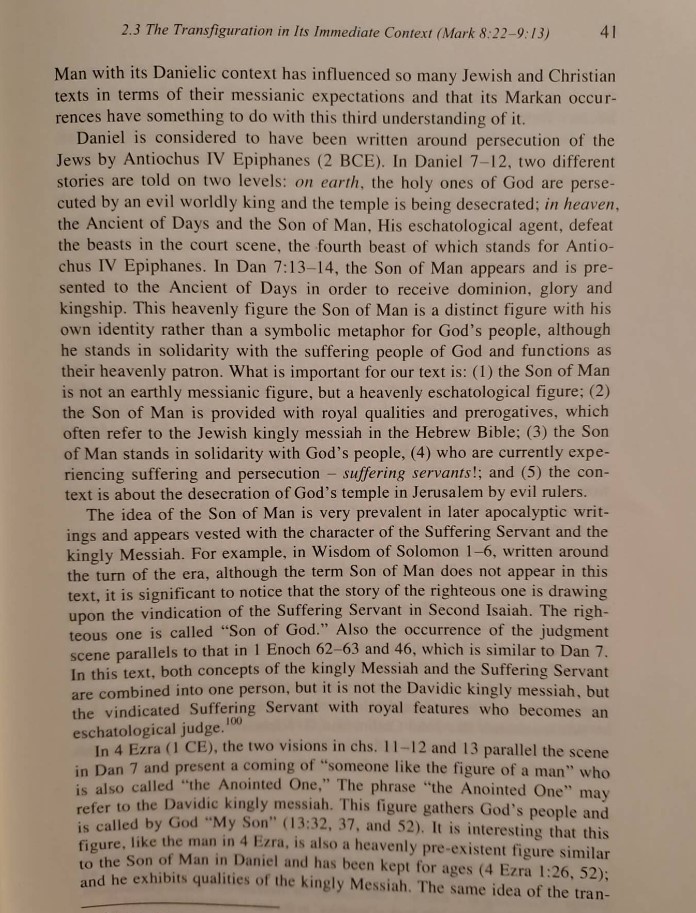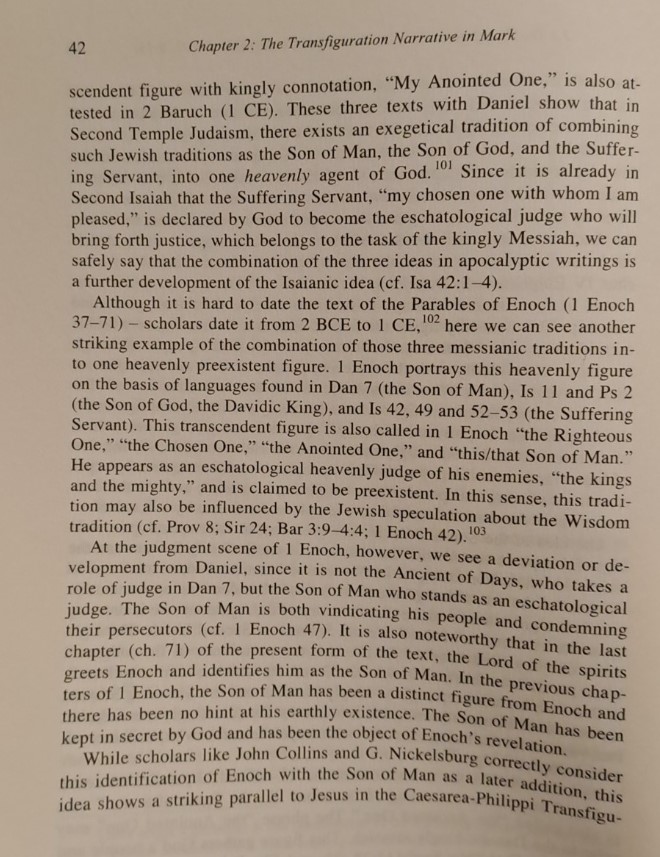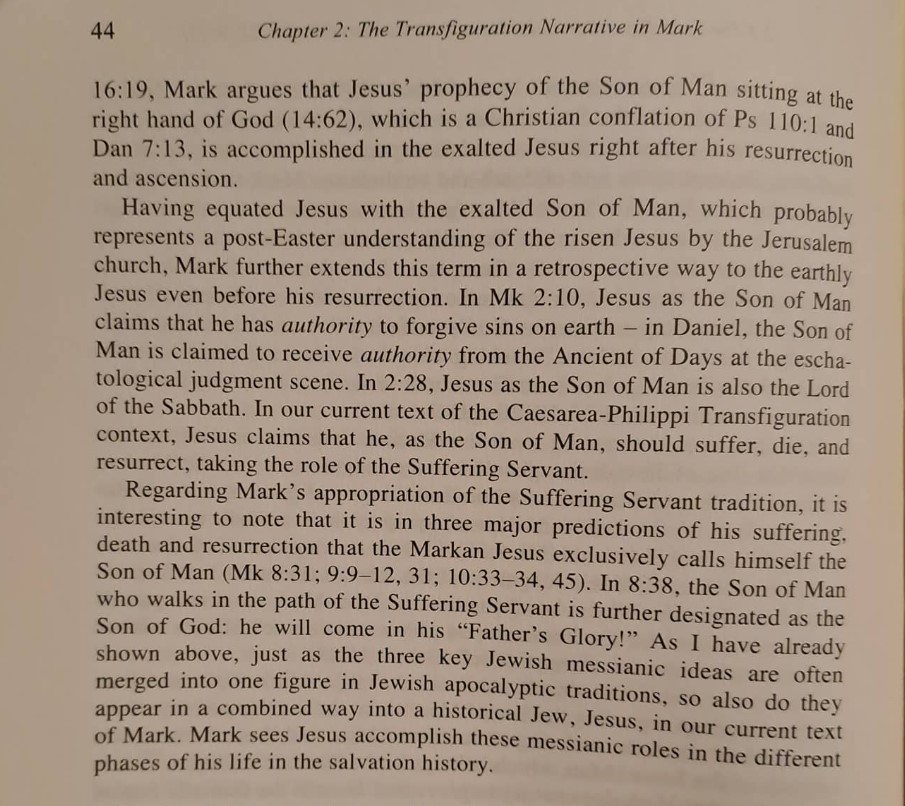Simon S. Lee provides an overview of the "Son of Man" in messianic expectation and Mark's appropriation of the Suffering Servant to interpret Daniel's Son of Man and Jesus.
- Type
- Book
- Source
- Simon S. Lee Non-LDS
- Hearsay
- DirectSecondary
- Reference
Simon S. Lee, Jesus’ Transfiguration and the Believers’ Transformation (Wissenschaftliche Untersuchungen Zum Neuen Testament 2.Reihe 265; Tübingen: Mohr Siebeck, 2009), 41-44
- Scribe/Publisher
- Mohr Siebeck
- People
- Simon S. Lee
- Audience
- Reading Public
- Transcription
Daniel is considered to have been written around persecution of the Jews by Antiochus IV Epiphanes (2 BCE). In Daniel 7-12, two different stories are told on two levels: on earth, the holy ones of God are persecuted by an evil worldly king and the temple is being desecrated; in heaven, the Ancient of days and the Son of Man, His Eschatological agent, defeat the beasts in the court scene, the fourth beast of which stands for Antiochus IV Epiphanes. In Dan 7;13-14, the Son of Man appears and is presented to the Ancient of Days in order to receive dominion, glory and kingship. This heavenly figure the Son of Man is a distinct figure with his own identity rather than a symbolic metaphor for God’s people, although he stands in solidarity with the suffering people of God and functions as their heavenly patron. What is important for our text is: (1) the Son of Man is not an earthly messianic figure, but a heavenly eschatological figure; (2) the Son of Man is provided with royal qualities and prerogatives, which often refer to the Jewish kingly messiah in the Hebrew Bible; 93) the Son of Man stands in solidarity with God’s people, (4) who are currently experiencing suffering and persecution – suffering servants!; and (5) the context is about the desecration of God’s temple in Jerusalem by evil rulers.
The idea of the Son of Man is very prevalent in later apocalyptic writings and appears vested with the character of the Suffering Servant and the kingly Messiah. For example, in Wisdom of Solomon 1-6, written around the turn of he era, although the term Son of Man does not appear in this text, it is significant to notice that the story of the righteous one is drawing upon the vindication of the Suffering Servant in Second Isaiah. The righteous one is called “Son of God.” Also the occurrence of the judgment scene parallels to that in 1 Enoch 62-63 and 46, which is similar to Dan 7. In this text, both concepts of the kingly Messiah and the Suffering Servant are combined into one person, but it is not the Davidic kingly messiah, but the vindicated Suffering Servant with royal features who becomes an eschatological judge.
In 4 Ezra (1 CE), the two visions in chs. 11-12 and 13 parallel the scene in Dan 7 and present a coming of “someone like the figure of a man” who is also called “the Anointed One.” The phrase “The Anointed One” may refer to the Davidic kingly messiah. This figure fathers God’s people and is called by God “My Son” (13:32, 37, 52). It is interesting that this figure, like the man in 4 Ezra is also a heavenly pre-existent figure similar to the Son of Man in Daniel and has been kept for ages (4 Ezra 1:26, 52); and he exhibits qualities of the kingly Messiah. The same idea of the transcendent figure with kingly connotation, “My Anointed One,” is also attested in 2 Baruch (1 CE). These three texts with Daniel show in Second Temple Judaism, there exists an exegetical tradition of combining such Jewish traditions as the Son of Man, the Son of God, and the Suffering Servant, not one heavenly agent of God. Since it is already in Second Isaiah that the Suffering Servant, “my chosen one with whom I am pleased,” is declared by God to become the eschatological judge who will bring forth justice, which belongs to the task of the kingly Messiah, we can safely say that the combination of the three ideas in apocalyptic writings is a further development of the Isaianic idea (cf. Isa 42:1-4).
Although it is hard to date the text of the Parables of Enoch (1 Enoch 37-71)—scholars date it from 2 BCE to 1 CE, here we can see another striking example of the combination of those three messianic traditions in to the basis of languages found in Dan. 7 (the Son of Man), Is 11 and Ps 2 (the Son of God, the Davidic King), and Is 42, 49, and 52-53 (the Suffering Servant). This transcendent figure is also called in 1 Enoch “the Righteous One,” “the Chosen One,” “the Anointed One,” and “this/that Son of Man.” He appears as an eschatological heavenly judge of his enemies, “the kings of the mighty,” and is claimed to be preexistent. In this sense, this tradition may also be influenced by the Jewish speculation about the Wisdom tradition (cf. Prov 8; Sir 24; Bar 3:9-4:4; 1 Enoch 42).
At the judgment scene of 1 Enoch, however, we see a deviation or development from Daniel, since it is not the Ancient of Days, who takes a role of judge in Dan 7, but the Son of Man who stands as an eschatological judge. The Son of Man is both vindicating his people and condemning their persecutors (cf. 1 Enoch 47). IT is also noteworthy that in the last chapter (ch. 71) of the present form of the text, the Lord of the spirits greets Enoch and identifies him as the Son of Man. In the previous chapters of 1 Enoch, the Son of Man has been a distinct figure from Enoch and there has been no hint at his earthly existence. The Son of Man has been kept in secret by God and has been the object of Enoch’s revelation.
While scholars like John Collins and G. Nickelsburg correctly consider this identification of Enoch with the Son of Man as a later addition, this idea shows a striking parallel to Jesus in the Caesarea-Philippi Transfiguration context. In our current text of Mark 8:27-9:13, Jesus, a Jew on earth, is claimed to be the Son of Man, eschatological heavenly judge; furthermore, he is called God’s Son and is expected to take the role of the Suffering Servant in his fate of death and vindication. Mark finds it appealing to adopt the Danielic Son of Man for his description of Jesus, not least because there is a parallel in the Danielic context and his own, especially desecration or destruction of the Temple in Jerusalem and the context of suffering. All of these Jewish messianic ideas help Mark understand Jesus’ earthly and heavenly ministry as God’s suffering Son and the eschatological judge. Mark puts in Jesus’ teaching what these ideas tell about his ministry, and the Transfiguration confirms both visually and audibly this Markan understanding of Jesus’ fulfilling these roles.
It is, however, interesting to note a Markan deviation or development from this line of Jewish thought that at the judgment scene, the Markan Jesus as the Son of Man will not condemn kings and powers, but will decide the fate of the believers depending upon their attitude toward the earthly Jesus and his words (Mk 8:38). It is striking that Mark does not mention the Son of Man’s judgment of the Roman rulers for the destruction of the Temple. Why is he silent about it? Does Mark see it as part of God’s plan, in which the Roman rulers play a certain role? Mark’s answer to the question may be affirmative (cf. 13:1-2; 15:38).
Ferdinand Hahn has already maintained that in Mark there are three types of saying regarding the Son of Man: about the earthly activity of the Son of Man, about the suffering of the Son of Man, and about the heavenly activity of the Son of Man, which belongs to the Danielic tradition. It is interesting that Mark does not try to prove that Jesus is the Danielic Son of Man, but instead, presupposes it. Even in the other synoptic gospels, the term Son of Man is never explicated in any way, but is always assumed that Jesus’ hearers will understand perfectly what he means when he speaks of “the Son of Man.” In Mark, Jesus treats the Son of Man as a known quantity and does not hesitate to refer this term to himself (2:10; 8;31-38; 14:62). The heavenly Son of Man with its Danielic echo is clearly found in 8:38; 13:26; and 14:62. The Son of Man in Mark is an exalted heavenly Judge as well as a cosmic ruler, but he has to go through humiliation in the unfolding drama of God’s saving act of His people. In Mark16:19, Mark argues that Jesus’ prophecy of the Son of Man sitting on the right hand of God (14:62), which is a Christian conflation of Ps 110:1 and Dan 7:13, is accomplished in the exalted Jesus right after his resurrection and ascension.
Having equated Jesus with the exalted Son of Man, which probably represents a post-Easter understanding of the risen Jesus by the Jerusalem church. Mark further extends this term in a retrospective way to the earthly Jesus even before his resurrection. In Mk 2:10, Jesus as the Son of Man claims that he has authority to forgive sins on earth—in Daniel, the Son of Man is claimed to receive authority from the Ancient of Days at the eschatological judgment scene. In 2:28, Jesus as the Son of Man is also the Lord of the Sabbath. In our current text of the Caesarea-Philippi Transfiguration context, Jesus claims that he, as the Son of Man, should suffer, die, and resurrect, taking the role of the Suffering Servant.
Regarding Marks’s appropriation of the Suffering Servant tradition, it is interesting to note that it is in three major predictions of his suffering, death and resurrection that the Markan Jesus exclusively calls himself the Son of Man (Mk 8:31; 9:9-12, 31; 10:33-34, 45). In 8:38, the Son of Man who walks in the path of the Suffering Servant is further designated as the Son of God: he will come in his “Father’s Glory”! As I have already shown above, just as the three key Jewish messianic ideas are often merged into one figure in Jewish apocalyptic traditions, so also do they appear in a combined way into a historical Jew, Jesus, in our current text of Mark. Mark sees Jesus accomplish these messianic roles in the different phases of his life in the salvation history.
- Citations in Mormonr Qnas
The B. H. Roberts Foundation is not owned by, operated by, or affiliated with the Church of Jesus Christ of Latter-day Saints.




